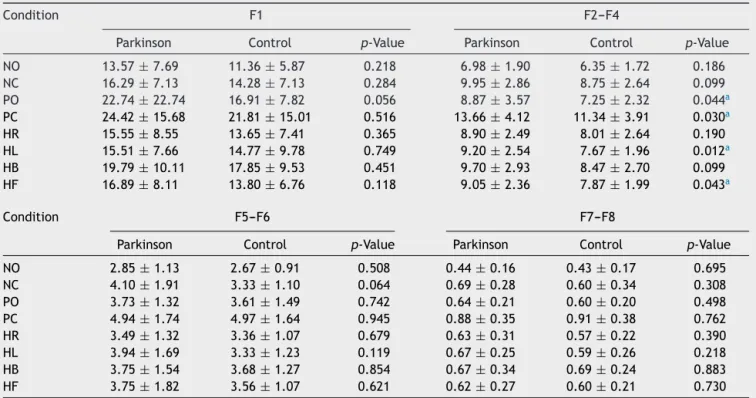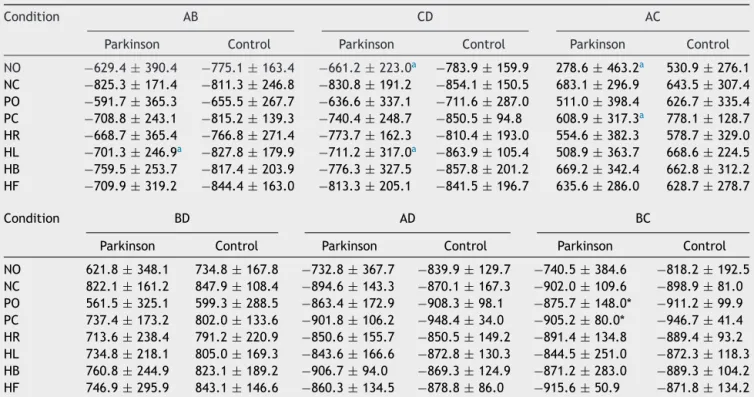Brazilian
Journal
of
OTORHINOLARYNGOLOGY
www.bjorl.org
ORIGINAL
ARTICLE
Postural
control
in
Parkinson’s
disease
夽
Jackeline
Yumi
Fukunaga
a,∗,
Rafaela
Maia
Quitschal
a,
Flávia
Doná
b,
Henrique
Ballalai
Ferraz
c,
Maurício
Malavasi
Gananc
¸a
d,
Heloísa
Helena
Caovilla
eaPost-GraduatePrograminHumanCommunicationDisorders,UniversidadeFederaldeSãoPaulo(UNIFESP),SãoPaulo,SP,Brazil bMasters’PrograminRehabilitationofBodyEquilibriumandofSocialInclusion,UniversidadeBandeirantedeSãoPaulo
(UNIBAN),SãoPaulo,SP,Brazil
cMovementDisorderUnit,DepartmentofNeurologyandNeurosurgery,UniversidadeFederaldeSãoPaulo(UNIFESP),
SãoPauloSP,Brazil
dEscolaPaulistadeMedicina,UniversidadeFederaldeSãoPaulo(UNIFESP),SãoPaulo,SP,Brazil
eDivisionofOtologyandOtoneurology,EscolaPaulistadeMedicina,UniversidadeFederaldeSãoPaulo(UNIFESP),
SãoPaulo,SP,Brazil
Received30August2013;accepted6December2013 Availableonline11June2014
KEYWORDS
Parkinsondisease; Posturalbalance; Vestibularfunction tests
Abstract
Introduction:PosturalinstabilityisoneofthemostdisablingfeaturesofParkinson’sdisease. Objective:ToevaluateposturalbalanceinParkinson’sdisease.
Methods:ThirtypatientswithParkinson’sdiseasewerecomparedwithcontrolsusingTetraxTM
interactivebalancesystemposturography.
Results:Fordifferentpositions,patientswithParkinson’sdiseaseshowedasignificantlyhigher weight distribution index, fall index, Fourier transformation at low-medium frequencies (F2---F4),andsignificantlylowerright/leftandtoe/heelsynchronizationversuscontrols. Conclusion:PosturalimbalanceinParkinson’sdiseasepatientsischaracterizedbythe abnor-malitiesofweightdistributionindex,synchronizationindex,Fouriertransformationindex,and fallindexasmeasuredbyTetraxTMposturography.
© 2014Associac¸ãoBrasileira de Otorrinolaringologiae CirurgiaCérvico-Facial. Publishedby ElsevierEditoraLtda.Allrightsreserved.
PALAVRAS-CHAVE
Doenc¸adeParkinson; Equilíbriopostural; Testesdefunc¸ão vestibular
ControleposturalnaDoenc¸adeParkinson
Resumo
Introduc¸ão:Ainstabilidadeposturaléumdosprincipaisproblemasnadoenc¸adeParkinson. Objetivo:Avaliarocontroleposturalnadoenc¸adeParkinson.
夽 Pleasecitethisarticleas:FukunagaJY,QuitschalRM,DonáF,FerrazHB,Gananc¸aMM,Caovilla HH.PosturalcontrolinParkinson’s
disease.BrazJOtorhinolaryngol.2014;80:508---14.
∗Correspondingauthor.
E-mail:jackelinefukunaga@yahoo.com.br(J.Y.Fukunaga).
http://dx.doi.org/10.1016/j.bjorl.2014.05.032
Método: Umgrupode 30pacientescomdoenc¸ade Parkinsonfoicomparadocomum grupo controleàposturografiaestáticadoTetraxInteractiveBalanceSystem(TetraxTM).
Resultados: Emdiferentes condic¸ões sensoriais,houvediferenc¸assignificantes entreosdois grupos,tendosidoencontradosnosparkinsonianosvalores maioresdoíndice dedistribuic¸ão de peso,do índice de risco dequeda e dafaixa de frequênciaF2-4 evalores menores da sincronizac¸ãodaoscilac¸ãoposturaldireito-esquerdaededos/calcanhares.
Conclusão:Ocomprometimentodocontroleposturalempacientescomdoenc¸adeParkinson écaracterizadoporalterac¸õesnadistribuic¸ãodepeso,nasincronizac¸ãodaoscilac¸ãopostural direita/esquerda e dedos/calcanhares,nas faixas defrequência de oscilac¸ão postural e no índicederiscodequedaàposturografiadoTetraxTM.
©2014Associac¸ãoBrasileiradeOtorrinolaringologiaeCirurgiaCérvico-Facial.Publicado por ElsevierEditoraLtda.Todososdireitosreservados.
Introduction
Postural balance can be defined as the ability of human beings to standup straight and performmovements with no oscillations or falls. Itsmaintenance is determinedby theintegrationinthecentralnervoussystemofinformation originating from the vestibular, visual, and propriocep-tive systems that trigger eye and spinal reflexes.1---4 The
vestibular-ocular reflex (VOR) generates eye movements,
promotingthestabilizationofgazeduringheadmovement;
the vestibulospinal reflex (VSR) generates compensatory
body movements in order to maintain head and postural
stability.5
Parkinson’sdiseaseisachronicandprogressive degener-ativedisorderof thecentralnervoussystem. Itaffectsall agegroups,butismostcommonlyfoundintheelderly
pop-ulation.Parkinson’s diseasecanbe considered thesecond
mostcommon senileneurodegenerative disease,affecting
approximately1%to2%ofthepopulationabove65yearsof age,6andoccursindifferentracesandsocialclassesinboth
genders,butisprevalentinmales.7
Parkinson’sdiseaseischaracterizedbyrigidity,
bradyki-nesia, micrography, mask-like facial expression, postural
changes,andrestingtremor.Posturalchangesincludelack
of balance reaction, adopting the posture in flexion, and
decreasedtrunkrotation.8Itisconsideredthatthefallrisk
inParkinson’sdiseasevariesbetween38%and68%,andthat recurrentfallsoccur moreofteninthelaterstagesof the disease.9
ThepathophysiologyofParkinson’sdiseaseisa progres-sivelossofcellsinthesubstantianigraofthemidbrain.The degenerationof neurons in thesubstantia nigra resultsin
decreasedproductionofdopamine,withdepigmentationof
thisstructure.7,8
Theetiologyremainsunknown,anditisbelievedthatthe
pathogenicmechanismsinvolvedaremultifactorial:
oxida-tive stress, mitochondrial abnormalities, excitotoxicity,
glialandinflammatoryfactors,environmentalneurotoxins, geneticfactors,andbrainaging.10,11
PatientswithParkinson’sdiseaseexhibitmoredifficulty
inexecutingsimultaneousmovementsandsequencialtasks
versussimpletasks,requiringthecompleteexecutionofone
movementbeforestartingthenext.8
Postural instability is a major problem in Parkinson’s
disease; it increases the frequency of fall episodes and
their consequences, and the likelihood of occurrence of
fallsincreasesaccordingtotheextentanddurationofthe disease.8,12
Progressionofthediseaseleadstoanimpairmentofgait
called festination, characterized by decreased speed and
shorteningofthestride,asifthepersonwerechasing his owncenterofgravity,withatendencytotipoverforward.
Festinantgaitmaybecaused byachangeofpressureand
masscenters,resultingin areductionof theresponses of balance,orasaresultofchangesingaitkinematics.
Changesingaitkinematicsincludechangesinjoint excur-sionandinhipflexion,whichcanmodifytheexcursionofthe heel.Insteadofaheel-toeprogression,thepatientmakes contactwiththegroundwithflatfeet;or,withtheadvance ofthedisease,thereisaheel-toeprogression,significantly compromisingthegait.8,13
Posturographymeasuresposturalinstability,assistsinthe analysisof thefunctionalaspectsofwhatever dysfunction causesthebodyimbalance,8,14,15complementsconventional
vestibulartestsfor diagnosis, andis relevant tothe stag-ing,treatment,andprognosisofParkinson’sdisease.16,17It
mayalsoidentifyearlysignsofbalanceimpairmentin dif-ferentconditions,suchaswitheyesopen,eyesclosed,and onunstablesurfaces.8,18
Researchhasdemonstratedthathealthyindividualshave
better postural control and a higher stability limit than
patientswithParkinson’sdiseaseintheonperiod,aphase wherethepatientisundertheinfluenceofanti-Parkinsonian
medicationandpresentsbettermotorperformance,andin
theoffperiod,wherethereisnoeffectofmedicationand
consequentlyaworseningofsymptoms;Parkinsonpatients
performbetterintheonperiodthanintheoffperiod.19,20
Mostposturographicdevicesincurrent useassumethat
themechanisms involved in postural controlcan be
mea-suredby analyzing the postural oscillation manifested by
a shifting of the center of gravity or pressure, while the subjectremainsstandingonaplatformsensitivetopressure. In TetraxTM (Sunlight Medical Ltd.) interactive balance
system posturography, created by Kohen-Raz with four
platforms,posturalcontrolisinvestigatedthroughthe dif-ferenceinpressureoneachplatform.Thisequipmentmakes itpossibletoobtainandseparatelycomparethevaluesof forefootandrearfoot(toesandheel)ofeachfoot,andof eachheelwiththecontralateralforefoot.21
The body balance of healthy individuals was analyzed
withTetraxTM indifferentsensoryconditions(eyesopenor
left,or witha tilt of 30◦ forward or backward,ona firm
orunstablesurface),withreferencetothegeneral stabil-ityindex,weightdistributionindex,synchronizationtothe right/left,synchronizationoftoes/heel,andfallrisk.22
Thisresearchwasmotivatedbytheauthors’findingthat onlytwostudiesusedTetraxTMinpatientswithParkinson’s
disease,23,24 and by the need to more broadly assess the
posturalcontrolofpatientswiththisdisease.
Objective
Thisstudyaimedtoassesstheposturalcontrolinpatients withParkinson’sdisease.
Methods
Thisclinical,cross-sectionalstudywithaconsecutive sam-plewasinitiatedafterareviewandapprovalbytheethics
committeeonresearchwithhumansubjectsunderNo.
1415-11.Allvolunteerswereevaluatedbetween2011and2012
andwere informedof the procedures that would be
per-formed; in addition,these volunteers signed an informed
consentallowingtheirparticipationinthestudyand subse-quentpublicationoftheresults.
Thirtymaleandfemalepatientswithneurological
diag-nosisofidiopathicParkinson’sdisease(experimentalgroup), classifiedinstagesI---IIIoftheHoehnandYahrScale,were included.25 The diagnosis wasbasedonthecriteriaofthe
BrainBankfor NeurologicalDiseases,NationalHospitalfor
NeurologyandNeurosurgery,inLondon,whichrequiresthe
presenceofbradykinesiaandatleastoneofthethree car-dinalsigns of Parkinson’s disease: tremor at rest, muscle rigidity,andposturalinstability.26
The control group wasmatched for age and gender in
relationtotheexperimentalgroup,andincluded29 volun-teersfromthecommunity.Inclusioncriteriaforthisgroup
weretheabsenceofneurologicaldiseasesandbody
imbal-ance, nohistory of vestibular and/or auditory symptoms,
anda vectoelectronystagmographyvestibularexamination
withinnormalreferenceparameters.
The exclusion criteria included patients who showed
changes in the external and/or middle ear those with
psychiatric disorders, history of ear; surgery, inability to understandandfollowsimpleverbalcommands,inabilityto
remainin theupright position independently;or whohad
severevisualimpairmentnotcompensatedwithcorrective
lenses,orthopedicdisordersresultinginlimitedmovement,
usedprosthetic legs, or whohave receivedbody balance
rehabilitationinthelastsixmonths.
Patientswith Parkinson’s diseasewere assessed during
the on period, between 40min and 2h after
adminis-tration of levodopa, when they exhibited better motor
performance.27
StaticTetraxTMposturographyincludesaspecificprogram
installedonacomputerizedplatformcomposedoffour inde-pendent and integrated platforms (A---B---C---D), placed on
levelground,uncarpeted,withahandrailandafoammat.
Patients placed their toes and heels on the four
plat-forms(A---leftheel;B---lefttoes;C---rightheel,D---right
toes)witharmsoutstretchedalongsidethebody,andwere
instructed to maintain an upright, stable, and immobile
posture for 32s for each of the eightsensory conditions:
‘‘face forward, eyes open, looking at a target on the
wall opposite the platform on firm surface’’ (NO); ‘‘face
forward,eyesclosedonafirmsurface’’(NC);‘‘eyesclosed, 45◦ ofheadrotationtotheright onafirmsurface’’(HR);
‘‘eyes closed, 45◦ of head rotation to the left on a firm
surface’’(HL); ‘‘eyesclosed,head tilted30◦ backwardon
afirmsurface’’(HB);‘‘eyesclosed,headtilted30◦forward
onafirmsurface’’(HF),‘‘faceforward,eyesopen,looking atatargetonthewalloppositetheplatformonaunstable surfaceonacushion’’(PO);and‘‘faceforward,eyesclosed onanunstablesurfaceonacushion’’(PC).
The posturographywithTetraxTM evaluatedthe
follow-ingparameters: stabilityindex,weightdistributionindex,
left/right and toes/heel synchronization index, postural
oscillation frequency (F1,F2---F4, F5---F6, and F7---F8), and fallindex.28
Thestabilityindex,regardlessofweightandheight, indi-catestheoverall stabilityandtheabilitytomakepostural
changes. This indexassesses the amount of oscillationon
thefourplatformsofTetraxTM.28
The weightdistributionindex,expressed asa
percent-age, is measured by comparing the deviations from the
weight distribution on each platform with respect to an
expectedaveragevalueof25%.28
The synchronization index between the heel and toes
of each foot (AB, CD), between the two heels and toes
of both feet (AC, BD),and between the heelof one foot
withthecontralateraltoes (AD,BC)measures the
coordi-nation between thelower limbsand thesymmetry in the
distributionofweightineachcondition.28
The frequency of postural oscillation, measured by
Fouriertransformation,determinestheintensityofpostural oscillationinavariablespectrumbetween0.01and3.0Hz. TetraxTM subdividesthespectrumofpostural oscillationin
four frequency ranges: low (F1), below 0.1Hz;
medium-low(F2---F4),between0.1and0.5Hz;medium-high(F5---F6), between0.5and1.0Hz;andhigh(F7---F8),above1.0Hz.28
The fall index,expressed asa percentage andranging
between0and100,analyzestheresultsofTetraxTM
param-etersintheeightconditions.Avaluebetween0%and36%is judgedasmildrisk;avaluebetween37%and58%,as moder-aterisk;andbetween59%and100%,ashighrisk.Thehigher thescore,thegreatertheriskofoccurrenceofafall.28
Alldataweresubmittedtodescriptivestatisticsfor sam-plecharacterization.Levene’stestwasusedtoanalyzethe equivalenceofvarianceswithrespecttoage,andthe
chi-squared test was usedfor the analysisof homogeneity of
genres betweenthecontrolandexperimentalgroups.The
Shapiro---Wilktest wasusedtoverifythe normalityof the variables.
In the comparative analysis of experimental and
con-trolgroups,thenonparametricMann---Whitneytestwasused for theoverallstabilityindex,forleft-rightandtoes/heel
synchronization in the eight sensory conditions, and for
theweightdistributionindexinthe‘‘NO’’,‘‘NC’’, ‘‘PO’’, ‘‘HR’’, ‘‘HL’’, and ‘‘HB’’conditions. Student’s t-test was
used for independent samples, regarding age, fall index,
postural oscillation frequencies (F1, F2---F4, F5---F6, and
F7---F8) in all conditions, and weight distribution index
in ‘‘PC’’ and ‘‘HF’’ conditions. Data were presented as
Table1 AnalysisofthestabilityindexandweightdistributionindexintheeightconditionsoftheTetraxTMinteractivebalance
systemin29controlsubjectsand30patientswithParkinson’sdisease.
Condition Stabilityindex Weightdistributionindex
Parkinson Control p-Value Parkinson Control p-Value
NO 14.2±4.7 13.3±3.5 0.832a 7.1±3.4 4.9±2.6 0.015a,b
NC 20.8±9.6 18.4±6.1 0.628a 6.5±3.1 4.7±2.4 0.042a,b
PO 19.1±5.9 18.2±6.7 0.363a 7.1±2.9 5.0±2.6 0.005a,b
PC 27.9±9.3 28.4±10.7 0.891a 7.3±2.7 4.2±2.2 <0.001b,c
HR 19.5±7.6 17.9±5.4 0.638a 6.6±3.5 5.4±2.8 0.159a
HL 21.1±8.4 17.9±6.5 0.141a 7.1±3.1 5.5±2.6 0.060a
HB 20.9±9.3 19.7±6.4 0.952a 6.4±2.9 5.2±2.9 0.111a
HF 19.6±8.6 18.0±4.5 0.879a 6.5
±3.0 5.4±2.5 0.163c
NO,eyesopenonafirmsurface;NC,eyesclosedonafirmsurface;PO,eyesopenonanunstablesurface;PC,eyesclosedonanunstable surface;HR,eyesclosedwithheadrotationtotherightonafirmsurface;HL,eyesclosedwithheadrotationtotheleftonafirm surface;HB,eyesclosed,headtiltedbackward30◦onafirmsurface;HF,eyesclosed,headtiltedforward30◦onafirmsurface.
Values=mean±standarddeviation. a Mann---Whitneytest.
b Statisticallysignificantdifferencebetweenthegroups(p<0.05). c Student’st-test.
setatp<0.05.PredictiveAnalyticsSoftware(PASW,version 18.0)wasusedforcalculations.
Results
Atotalof59patientswereevaluated:30intheexperimental group,ofwhom18(60.0%)weremaleand12(40.0%)female,
and29inthecontrolgroup,ofwhom11(37.9%)weremale
and18 (62.1%)female.The mean age(±SD)ofthe group
withParkinson’sdisease was59.8±10.3 years. The mean
age (±SD) of thecontrol group was58.9±9.8 years.The groupswerehomogeneouswithrespecttogender(p=0.151) andage(p=0.488).
Onaverage,theriskofoccurrenceofafallwasmoderate (mean±SD=42.1±25.5) in patients with Parkinson’s dis-easeandmild(mean±SD=22.7±13.7)inthecontrolgroup. ThegroupwithParkinson’sdiseaseshowedahigherriskof
fallversusthecontrolgroup,withastatisticallysignificant
difference(p=0.001).
Table1presentsa comparativeanalysisof thestability
indexand ofthe weightdistributionindexof both groups
onTetraxTM.Therewasnostatisticallysignificantdifference
betweenthegroupsregardingthestabilityindexinthe stud-iedconditions.Theweightdistributionindexwashigherin patientswithParkinson’sthaninthecontrolgroupinall con-ditionsofTetraxTM,withastatisticallysignificantdifference
in‘‘NO’’,‘‘NC’’,‘‘PO’’,and‘‘PC’’conditions.
Table 2shows thecomparative analysisofthe postural oscillationfrequencyranges(F1,F2---F4,F5---F6,andF7---F8) inthecontrolandexperimentalgroupsintheeightsensory conditionsofTetraxTM. ThegroupwithParkinson’sdisease
hadhighervaluesversusthecontrolgroupinallfrequency rangesandinallsensoryconditions.
Therewasastatisticallysignificantdifferencebetween thegroupsintheF2---F4rangein‘‘PO’’,‘‘PC’’,‘‘HL’’,and ‘‘HF’’conditions.Therewasnostatisticallysignificant dif-ferencein‘‘NO’’,‘‘NC’’,‘‘HR’’,and‘‘HB’’conditions.
Table3showsthecomparativeanalysisoftheright/left
and toes/heel synchronization index of the control and
experimental groups in the eight sensory conditions of
TetraxTM.
Therewasastatisticallysignificant differencebetween
thegroups, withlowervalues in the group of Parkinson’s
patients in synchronizations ‘‘CD’’ (p=0.018) and ‘‘AC’’ (p=0.033) in ‘‘NO’’ condition; in synchronization ‘‘BC’’ (p=0.017) in ‘‘PO’’ condition; in synchronizations ‘‘BC’’ (p=0.035) and ‘‘AC’’ (p=0.049) in ‘‘PC’’ condition; in synchronizations ‘‘AB’’ (p=0.041) and ‘‘CD’’ (p=0.022)
in ‘‘HL’’ condition. The difference between the
synchro-nization indexes AB ‘‘exhibited’’ borderline significance
(p=0.05) in ‘‘PC’’. There was no significant difference
between the groups in synchronizations AB, CD, AC, BD,
AD, and BC (p>0.05) in ‘‘NC’’, ‘‘HR’’, ‘‘HB’’ and ‘‘HF’’ conditions.
Discussion
The findings of the static TetraxTM posturography in the
groupofpatients withParkinson’sdiseasewere compared
tothoseobtained in the control group. There are
limita-tionsin thequantitative comparisonof resultswiththose ofotherposturographies,sinceTetraxTMemploysdifferent
parametersandmethodsofevaluation.
TetraxTMprovidesthefallindexthroughamathematical
algorithmwhichisbasedonthepatient’sperformanceinthe variousevaluatedparameters.28 In the present study,the
riskofoccurrenceofafallwas,onaverage,mildinthe con-trolgroupandmoderateintheParkinson’sdiseasegroup;it wassignificantlyhigherinpatientswithParkinson’sdisease,
inagreementwiththefindingsof asurveyalsoconducted
withTetraxTM in mild or moderate Parkinson’sdisease, in
accordancewiththeHoehn-Yahrscale(modified),23 butin
disagreementwithanother study onpatients in the early
stagesofParkinson’sdisease,whichidentifiednosignificant differenceversuscontrolgroup.24
PosturalinstabilityisamajorprobleminParkinson’s dis-ease,andtheoccurrenceoffallsisoneofitsmostserious
Table2 ComparativeanalysisofFourierfrequencyrangesintheeightconditionsoftheTetraxTM interactivebalancesystem
in29controlsubjectsand30patientswithParkinson’sdisease.
Condition F1 F2---F4
Parkinson Control p-Value Parkinson Control p-Value
NO 13.57±7.69 11.36±5.87 0.218 6.98±1.90 6.35±1.72 0.186 NC 16.29±7.13 14.28±7.13 0.284 9.95±2.86 8.75±2.64 0.099 PO 22.74±22.74 16.91±7.82 0.056 8.87±3.57 7.25±2.32 0.044a
PC 24.42±15.68 21.81±15.01 0.516 13.66±4.12 11.34±3.91 0.030a
HR 15.55±8.55 13.65±7.41 0.365 8.90±2.49 8.01±2.64 0.190
HL 15.51±7.66 14.77±9.78 0.749 9.20±2.54 7.67±1.96 0.012a
HB 19.79±10.11 17.85±9.53 0.451 9.70±2.93 8.47±2.70 0.099
HF 16.89±8.11 13.80±6.76 0.118 9.05±2.36 7.87±1.99 0.043a
Condition F5---F6 F7---F8
Parkinson Control p-Value Parkinson Control p-Value
NO 2.85±1.13 2.67±0.91 0.508 0.44±0.16 0.43±0.17 0.695
NC 4.10±1.91 3.33±1.10 0.064 0.69±0.28 0.60±0.34 0.308
PO 3.73±1.32 3.61±1.49 0.742 0.64±0.21 0.60±0.20 0.498
PC 4.94±1.74 4.97±1.64 0.945 0.88±0.35 0.91±0.38 0.762
HR 3.49±1.32 3.36±1.07 0.679 0.63±0.31 0.57±0.22 0.390
HL 3.94±1.69 3.33±1.23 0.119 0.67±0.25 0.59±0.26 0.218
HB 3.75±1.54 3.68±1.27 0.854 0.67±0.34 0.69±0.24 0.883
HF 3.75±1.82 3.56±1.07 0.621 0.62±0.27 0.60±0.21 0.730
NO,eyesopenonafirmsurface;NC,eyesclosedonafirmsurface;PO,eyesopenonanunstablesurface;PC,eyesclosedonanunstable surface;HR,eyesclosedwithheadrotationtotherightonafirmsurface;HL,eyesclosedwithheadrotationtotheleftonafirm surface;HB,eyesclosed,headtilted30◦backwardonafirmsurface;HF,eyesclosed,headtiltedforward30◦onfirmsurface.
F1,F2---F4,F5---F6,F7---F8,posturaloscillationfrequencyranges. Valuesareshownasmean±standarddeviation.
Student’st-test.
aStatisticallysignificantdifferencebetweenthegroups(p<0.05).
variesbetween38%and68%.9Withdiseaseprogression,the
frequencyoffallsincreases.29 Theidentificationofthefall
riskcanlessentheriskfortheoccurrenceofthiseventinthe future,throughearlyintervention.30Moststudies
investigat-ingthefallriskusedatafromquestionnairesorin patient reportstopredict futurefalls. However,patientsoften do
notaccurately remember the details of previous falls, of
theintervalbetweentheevents,and,importantly,whether theyhaveoccurredoveralongperiodoftime.31
Thevaluesoftheweightdistributionindexwere signifi-cantlyhigherinpatientswithParkinson’sdisease,compared
to that in the control group, in four of the eight
evalu-atedsensoryconditions:‘‘NO’’,‘‘NC’’,‘‘PO’’,and‘‘PC’’.
Similar to the present findings, another study23
employ-ing TetraxTM showed a significant difference in the ‘‘NO
and‘‘NC’’sensoryconditions;butunlikethepresentstudy results,significantlyhighervalueswereobservedin‘‘HR’’,
‘‘HB’’(headbackwards),andHF(‘‘headforward’’)
condi-tions.Thehighertheweightdistributionindex,thegreater thedifficultyinmaintainingposture.28
The stability index of the group with Parkinson’s
dis-ease was similar to that of the control group in all the
evaluatedsensoryconditions.However,comparedwiththe
controlgroup,inParkinson’sdiseaseitwasreportedthatthe stabilityindexinTetraxTM washigheronlyin‘‘NC’’
condi-tion, with nosignificant difference in other conditions.23
Withothertypesofstaticposturography,someauthorshave
demonstratedinParkinsonianpatientsasignificantlygreater
oscillation area in ‘‘eyes open and eyes closed on a firm
surface’’conditions,32---34whileothershaveobservedno
sig-nificantdifference.18,35
Thevalues ofleftandright toes/heels synchronization
indexofthecontrolgroupandofthegroupwithParkinson’s
disease weresymmetricalin theeightsensoryconditions.
However,thegroupwithParkinson’sdiseasehadsignificantly lowervaluesinsynchronizations‘‘CD’’and‘‘AC’’in‘‘NO’’ condition; ‘‘BC’’ in ‘‘PO’’ condition; ‘‘BC’’ and ‘‘AC’’ in ‘‘PCcondition’’;and‘‘AB’’and‘‘CD’’in‘‘HL’’ condition. SignificantlylowervalueswerereportedonlyinAC synchro-nization,inHBcondition.23The symmetryofthevaluesof
synchronizations could bedue toadequate compensatory
mechanismsandtothesimultaneousactivationofthe
par-allelplates.28
Regardingtheposturaloscillationfrequencyranges(F1, F2---F4, F5---F6, and F7---F8), the group with Parkinson’s disease showedsignificantlyhigher valuesversusthe
con-trol group only in the range F2---F4 in ‘‘PO’’, ‘‘PC’’,
‘‘HL’’ and ‘‘HF’’ conditions, suggesting peripheral vesti-bulardysfunction.28
Bothgroupsshoweddominanceofoscillationatlow fre-quencies,indicatingvisualpreferencetomaintainpostural control.28 Significant differences between the group with
Parkinson’sdiseaseandthecontrolgroup werealsofound
Table3 ComparativeanalysisofsynchronizationindexesintheeightconditionsoftheTetraxTMinteractivebalancesystemin
29controlsubjectsand30patientswithParkinson’sdisease.
Condition AB CD AC
Parkinson Control Parkinson Control Parkinson Control
NO −629.4±390.4 −775.1±163.4 −661.2±223.0a −783.9±159.9 278.6±463.2a 530.9±276.1
NC −825.3±171.4 −811.3±246.8 −830.8±191.2 −854.1±150.5 683.1±296.9 643.5±307.4 PO −591.7±365.3 −655.5±267.7 −636.6±337.1 −711.6±287.0 511.0±398.4 626.7±335.4 PC −708.8±243.1 −815.2±139.3 −740.4±248.7 −850.5±94.8 608.9±317.3a 778.1±128.7
HR −668.7±365.4 −766.8±271.4 −773.7±162.3 −810.4±193.0 554.6±382.3 578.7±329.0 HL −701.3±246.9a −827.8±179.9 −711.2±317.0a −863.9±105.4 508.9±363.7 668.6±224.5
HB −759.5±253.7 −817.4±203.9 −776.3±327.5 −857.8±201.2 669.2±342.4 662.8±312.2 HF −709.9±319.2 −844.4±163.0 −813.3±205.1 −841.5±196.7 635.6±286.0 628.7±278.7
Condition BD AD BC
Parkinson Control Parkinson Control Parkinson Control
NO 621.8±348.1 734.8±167.8 −732.8±367.7 −839.9±129.7 −740.5±384.6 −818.2±192.5 NC 822.1±161.2 847.9±108.4 −894.6±143.3 −870.1±167.3 −902.0±109.6 −898.9±81.0 PO 561.5±325.1 599.3±288.5 −863.4±172.9 −908.3±98.1 −875.7±148.0* −911.2±99.9 PC 737.4±173.2 802.0±133.6 −901.8±106.2 −948.4±34.0 −905.2±80.0* −946.7±41.4 HR 713.6±238.4 791.2±220.9 −850.6±155.7 −850.5±149.2 −891.4±134.8 −889.4±93.2 HL 734.8±218.1 805.0±169.3 −843.6±166.6 −872.8±130.3 −844.5±251.0 −872.3±118.3 HB 760.8±244.9 823.1±189.2 −906.7±94.0 −869.3±124.9 −871.2±283.0 −889.3±104.2 HF 746.9±295.9 843.1±146.6 −860.3±134.5 −878.8±86.0 −915.6±50.9 −871.8±134.2
AB,synchronizationindexbetweenplatformsregardinglefttoesandheel;CD,synchronizationindexbetweenrighttoesandheel;AC, synchronizationindexbetweenbothheels;BD,synchronizationindexbetweenbothforefeet;AD,synchronizationindexbetweenleft andrighttoes;BC,synchronizationindexbetweenlefttoesandrightheel;NO,eyesopenonafirmsurface;NC,eyesclosedonafirm surface;PO,eyesopenonanunstablesurface;PC,eyesclosedonanunstablesurface;HR,eyesclosedwithheadrotationtotheright onafirmsurface;HL,eyesclosedwithheadrotationtotheleftonafirmsurface;HB,eyesclosed,headtiltedbackward30◦onafirm
surface;HF,eyesclosed,headtiltedforward30◦onafirmsurface.
Valuesshownaremean±standarddeviation. Mann---Whitneytest.
a StatisticallysignificantdifferencebetweenthegroupwithParkinson’sdiseaseandthecontrolgroup(p<0.05).
‘‘HR’’,‘‘HF’’,and‘‘HB’’conditions;inF5---F6rangesinNC andHLconditions;andintheF7---F8rangesinNC,HL,and HRconditions.23
In patients in the early stages of Parkinson’s disease,
TetraxTMidentifiedgreaterinvolvementofthecentral
ves-tibularsystem,24 characterizedbygreateroscillationinthe
F7---F8frequencyrange.28Thedifferencefoundbetweenthe
groupsinF2---F4 rangemayhavebeen anattemptto
com-pensatefor aproprioceptive impairment.Thedecreasein
proprioceptiveinformationonunstablesurfaceconditions,
a restrictionof movementand arigidity tochange in the
headpositionmayhavehamperedthemaintenanceof
pos-ture. The deteriorationof proprioceptive information can
causeposturalinstability.36---38
In this research, it was observed that the TetraxTM
posturographyprovidesrelevantinformationregardingthe
stability index, weight distribution index, right/left and toes/heelssynchronizationindex,frequencyrangesof pos-turaloscillation(F1,F2---F4,F5---F6, F7---F8),andfallindex intheassessmentofposturalcontrolinParkinson’sdisease.
Thecharacterizationofabodybalancedisorderineach
patient with this condition may have diagnostic,
thera-peutic,andevenpreventiveimplications.Furtherresearch shouldbeconductedinthisareainordertobetter
under-stand the relationship among postural control and the
differentstagesofParkinson’sdisease,aswellasthe possi-bleroleofprophylacticortherapeuticproceduresforbody balance rehabilitation in solving or mitigating the imbal-anceandineliminatingorreducingtheriskoffallsinthese patients.
Conclusion
Impairedpostural controlin patientswithParkinson’s dis-easeinTetraxTMposturographyischaracterizedbychanges
indistributionofweightinthesynchronizationofright/left andtoes/heelsposturaloscillation,inthepostural oscilla-tionfrequencyranges,andinthefallindex.
Funding
This study was supported by Coordenac¸ão de
Aperfeic¸oamentodePessoaldeNívelSuperior---CAPES.
Conflicts
of
interest
References
1.CaovillaHH,Gananc¸aMM,MunhozMSL,SilvaMLG,FrazzaMM. OEquilíbriocorporaleseusdistúrbios:lidandocomopaciente vertiginoso.RevBrasMedOtorrinolaringol.1997;4:47---51.
2.Pedalini MEB, Bittar RSM, Formigoni LG, Cruz OLM, Bento RF,MinitiA.Reabilitac¸ãovestibularcomotratamentoda ton-tura: experiência com 116 casos. Arq Int Otorrinolaringol. 1997;3:87---90.
3.Gananc¸aMM,Caovilla HH.Equilibriometria.In:Gananc¸aMM, VieiraRM,CaovillaHH,editors.Princípiosdeotoneurologia.São Paulo:Atheneu;1998.p.23---55.
4.SchubertMC,MinorLB.Vestibulo-ocularphysiologyunderlying vestibularhypofunction.PhysTher.2004;84:373---85.
5.HainTC,RamaswamyTS,HillmanMA.Anatomiaefisiologiado sistemavestibularnormal.In:HerdmanSJ,editor.Reabilitac¸ão vestibular.2nded.SãoPaulo:Manole;2002.p.3---24.
6.DeRijkMC,TzourioC,BretelerMMB.Prevalenceof parkinso-nismandParkison’sdiseaseinEurope:theEuroparkinson col-laborativestudy.JNeurolNeurosurgPsychiatry.1997;62:10---5.
7.Menezes MS,Teive HAG.Introduc¸ãoCap. 1.In:Menezes MS, TeiveHAG,editors.Doenc¸adeParkinson.RiodeJaneiro: Gua-nabaraKoogan;2003.p.1---2.
8.MelnickME.Distúrbiosmetabólicoshereditáriosegenéticosdos núcleosdabaseemadultos.Cap.24.In:UmphredDA,editor. Reabilitac¸ãoNnurológica.5thed.SãoPaulo:Elsevier;2009.p. 705---18.
9.BalashY,PeretzC,LeibovichG,HermanT,HausdorffJM,Giladi N. Falls in outpatients with Parkinson’s disease: frequency, impactandidentifyingfactors.JNeurol.2005;252:1310---5.
10.TeiveHAG.Etiopatogeniadadoenc¸adeParkinson.In:Menezes MS,TeiveHAG,editors.Doenc¸adeParkinson.RiodeJaneiro: GuanabaraKoogan;2003.p.32---7.
11.Teive HAG, Neuroprotec¸ão:. Fatos mitos e quimeras. In: AndradeLAF,BarbosaER,CardosoF,TeiveHAG,editors.Doenc¸a de Parkinson: estratégias atuais de tratamento. São Paulo: Lemos;1999.p.17---35.
12.MakMKY,PangMYC.Balanceconfidenceandfunctionalmobility areindependentlyassociatedwithfallsinpeoplewith Parkin-son’sdisease.JNeurol.2009;256:742---9.
13.Merello M, Fantacone N, Balej J. Kinematic studyof whole body center of mass position during gait in Parkinson’s dis-ease patients with and without festination. Mov Disord. 2010;25:739---46.
14.Visser JE, Carpenter MG,Kooij HVD,Bloem BR. The clinical utilityofposturography.ClinNeurophysiol.2008;119:2424---36.
15.NepomucenoMM,FormigoniCE,FerrioliE.Estudodoequilíbrio corporal em adultos idososavaliados em posturografia com-putadorizada. Acta ORL/Técnicas Otorrinolaringol. 2010;28: 44---51.
16.BittarRSM.Como a posturografia dinâmica computadorizada podenosajudarnoscasosdetontura?ArqIntOtorrinolaringol. 2007;11:330---3.
17.EbersbachG,GunkelM.Posturographyreflectsclinical imbal-anceinParkinson’sdisease.MovDisord.2011;26:241---6.
18.ValkovicP,AbrahámováD,HlavackaF,BenetinJ.Static post-urographyand infraclinical posturalinstability in early-stage Parkinson’sdisease.MovDisord.2009;24:1713---4.
19.Mancini M, Rocchi L, Horak FB, Chiari L. Effects of Parkin-son’sdiseaseandlevodopaonfunctionallimitsofstability.Clin Biomech.2008;23:450---8.
20.MenantJC,LattMD,MenzHB,FungVS,LordSR.Posturalsway approachescenterofmassstabilitylimitsinParkinson’sdisease. MovDisord.2011;26:637---43.
21.Kohen-RazR.Posturo-graphicmethodusingfourthree dimen-sionallymovable platforms.UnitedStatesPatentApplication Publication;2007.
22.Fukunaga JY, QuitschalRM, Gananc¸a MM, Caovilla HH. Post-urographyoftheTetraxinteractivebalancesysteminhealthy individuals: preliminary study. Int Arch Otorhinolaryngol. 2012;16:17.
23.KimBR,ChoiKH,ChunMH,LeeMC,ChungSJ,JangKW. Evalu-ationofbalancecontrolinpatientswithidiopathicParkinson’s diseaseusingtetra-ataxiometricposturography.JKoreanAcad RehabilMed.2009;33:538---46.
24.GülerS,BirLS,ArdicF.Theeffectofpramipexoletherapyon balancedisorderand fallrisk inParkinson’s diseaseat early stage: clinical and posturographic assessment. ISRN Neurol. 2012;2012:320607.
25.HoehnMM,YahrMD.Parkinsonism:onset,progression,and mor-tality.Neurology.1967;17:427---42.
26.Hughes AJ, Daniel SE, Kilford L, Lees AJ. Accuracy of clinicaldiagnosisof idiopathicParkinson’s disease: a clinico-pathologicalstudyof100cases.JNeurolNeurosurgPsychiatry. 1992;55:181---4.
27.PintoRASR,BorgesV,AguiarPMC,FerrazFAP,HisatugoMK, Fer-razHB.Avaliac¸ãodasatividadesdavidadiáriadospacientes comdoenc¸adeParkinsonsubmetidosàcirurgiaestereotáxica. ArqNeuropsiquiatr.2002;60:435---41.
28.Tetrax.Guidaperoperatoreclinico.Italy:SunlightMedicalLtd; 2004.
29.Mata F, Barros A, Lima C. Avaliac¸ão do risco de quedas em pacientes com Doenc¸a de Parkinson. Rev Neurocienc. 2008;16:20---4.
30.EtmanA,WijlhuizenGJ,vanHeuvelenMJ,ChorusA, Hopman-RockM.Fallsincidenceunderestimatestheriskoffall-related injuriesinolderagegroups:acomparisonwiththeFARE(Falls riskbyExposure).AgeAgeing.2012;41:190---5.
31.PickeringRM,GrimbergenYA,RigneyU,AshburnA,Mazibrada G,WoodB,etal.Ameta-analysisofsixprospectivestudiesof fallinginParkinson’sdisease.MovDisord.2007;22:1892---900.
32.RocchiL,ChiariL,CappelloA.Featureselectionof stabilomet-ricparametersbasedonprincipalcomponentanalysis.MedBiol EngComput.2004;42:71---9.
33.ChastanN,DebonoB,MaltêteD,WeberJ.Discordancebetween measuredposturalinstabilityandabsenceofclinicalsymptoms inParkinson’sdiseasepatientsintheearlystagesofthedisease. MovDisord.2008;23:366---72.
34.BłaszczykJW, Orawiec R. Assessment of postural control in patientswithParkinson’sdisease:swayratioanalysis.HumMov Sci.2011;30:396---404.
35.MarcheseR, BoveM, AbbruzzeseG. Effect of cognitiveand motortasksonposturalstabilityinParkinson’sdisease:a pos-turographicstudy.MovDisord.2003;18:652---8.
36.VaugoyeauM,VielS, AssaianteC,AzulayAB.Impaired verti-calposturalcontrolandproprioceptiveintegrationdeficitsin Parkinson’sdisease.Neuroscience.2007;146:852---63.
37.CarpenterMG,BloemBR.PosturalcontrolinParkinsonpatients: aproprioceptiveproblem?ExpNeurol.2011;227:26---30.


